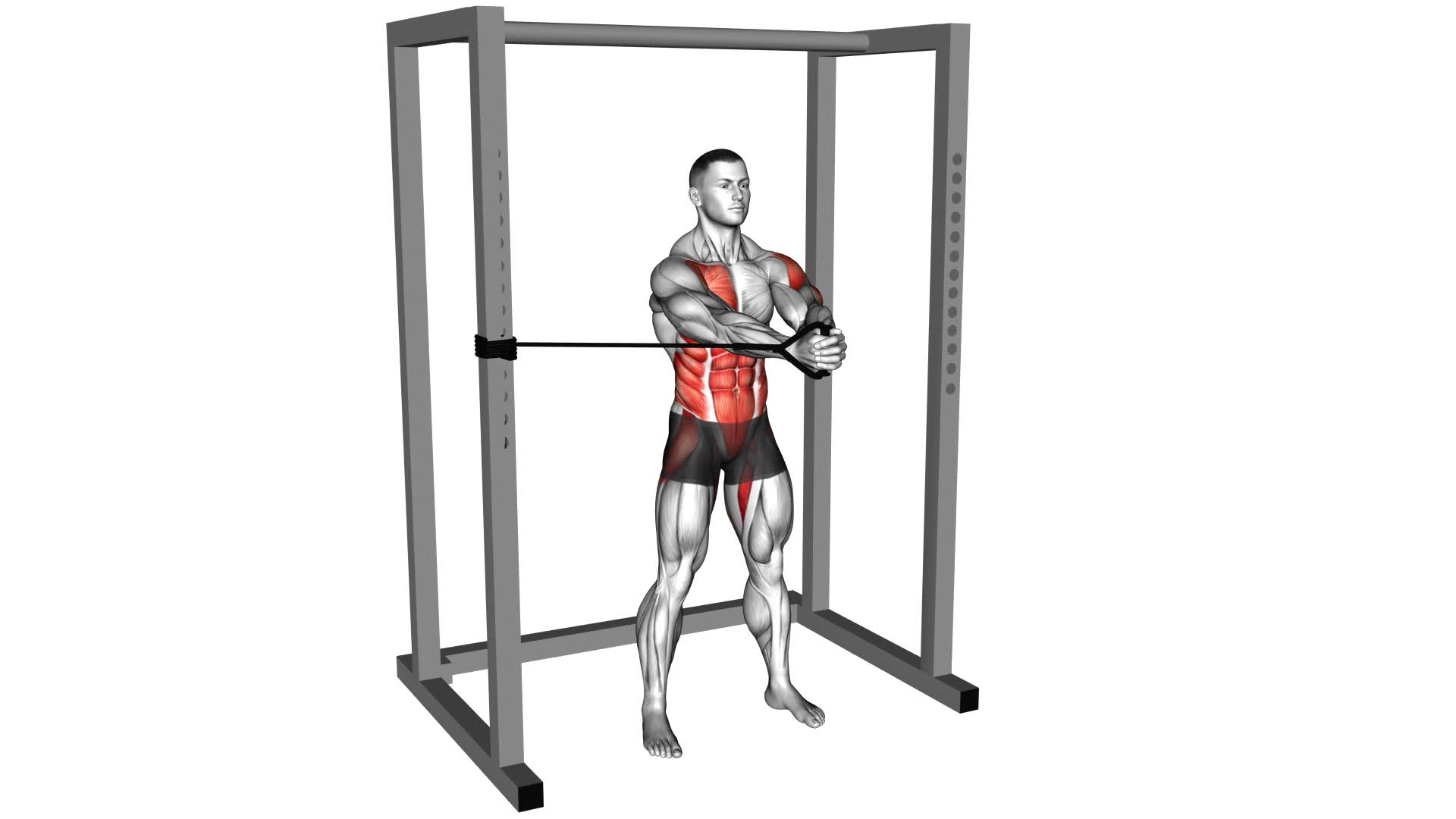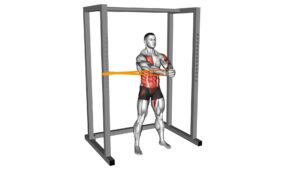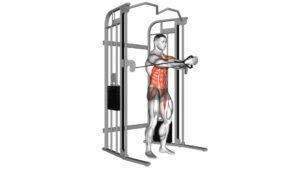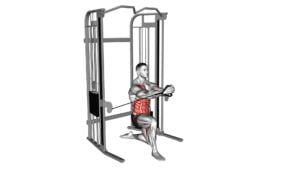Band Horizontal Pallof Press – Video Exercise Guide & Tips

Are you looking for a challenging exercise to strengthen your core? Look no further than the Band Horizontal Pallof Press.
Watch This Exercise Video
This video exercise guide and tips article will show you proper form and technique, variations to challenge yourself, common mistakes to avoid, and how to get the most out of this exercise.
Incorporate the Band Horizontal Pallof Press into your workout routine and watch your core strength improve.
Let's get started!
Key Takeaways
- Targets and engages deep core muscles
- Improves posture, balance, and overall core strength
- Enhances athletic performance
- Aids in injury prevention, particularly in the lower back and hips
Benefits of the Band Horizontal Pallof Press
You will experience numerous benefits from incorporating the Band Horizontal Pallof Press into your workout routine. This exercise, which utilizes band resistance, is highly effective for developing core stability.
The primary benefit of the Band Horizontal Pallof Press is its ability to target and engage the deep muscles of the core, including the transverse abdominis and obliques. By performing this exercise regularly, you'll strengthen these muscles, leading to improved posture, balance, and overall core strength.
Additionally, the Band Horizontal Pallof Press can help enhance your athletic performance. By stabilizing your core, you'll be able to generate more power and transfer force efficiently throughout your body. This can translate to improved performance in sports that require explosive movements, such as sprinting, jumping, and throwing.
Moreover, incorporating the Band Horizontal Pallof Press into your workout routine can aid in injury prevention. A strong and stable core is crucial for maintaining proper alignment and reducing the risk of injuries, particularly in the lower back and hips.
In the next section, we'll discuss the proper form and technique for performing the Band Horizontal Pallof Press to maximize its benefits.
Proper Form and Technique for the Exercise
To perform the Band Horizontal Pallof Press with proper form and technique, begin by selecting an appropriate resistance band. Here are some key tips to help you execute this exercise correctly and avoid common mistakes:
- Stand with your feet shoulder-width apart and loop the resistance band around a sturdy anchor point at chest height.
- Hold the band with both hands, and step away from the anchor point until you feel tension in the band.
- Position yourself perpendicular to the anchor point, with your arms extended straight in front of your chest.
- Engage your core and maintain a tall posture throughout the exercise.
- Slowly press the band away from your body, extending your arms fully, and then return to the starting position.
- Keep your movements controlled and avoid jerking or using momentum.
- Breathe steadily throughout the exercise, exhaling as you press the band away and inhaling as you return to the starting position.
Incorporating the Band Horizontal Pallof Press into your routine can help improve your core stability, enhance rotational strength, and prevent injuries. Remember to start with a lighter resistance band and gradually increase the tension as you gain strength and confidence.
Variations and Progressions to Challenge Your Core
Now that you have mastered the proper form and technique for the Band Horizontal Pallof Press, it's time to take your core strength to the next level with variations and progressions.
These advanced core exercises will challenge your core muscles in new ways and help you further increase your core strength and stability.
Advanced Core Exercises
Start challenging your core with advanced variations and progressions of core exercises. Take your core training to the next level with these advanced core exercises:
- Plank with shoulder taps: Engage your core and challenge your stability by adding shoulder taps to the traditional plank exercise. This exercise targets your abs, obliques, and shoulders, helping to improve overall core strength.
- Russian twists with a medicine ball: Sit on the floor with your knees bent and hold a medicine ball. Twist your torso from side to side, touching the ball to the ground on each side. This exercise works your obliques and improves rotational stability.
- Hanging leg raises: Hang from a pull-up bar and lift your legs up towards your chest. This exercise targets your lower abs and hip flexors, helping to improve core strength and stability.
Incorporate these advanced core exercises into your routine to challenge your core and take your fitness to new heights.
Increasing Difficulty Levels
Challenge your core even further with various variations and progressions that will increase the difficulty level of your workouts.
One way to do this is by increasing the intensity of the exercises. For example, you can add resistance bands to your exercises to provide additional resistance and challenge your muscles even more.
Another way to modify exercises is by changing the stability of your base. Instead of performing exercises on stable surfaces, try doing them on unstable surfaces like a balance board or stability ball. This will require your core muscles to work harder to maintain balance and stabilize your body.
By incorporating these variations and progressions into your workouts, you can continue to challenge and strengthen your core.
Now, let's move on to the next section about core strength variations.
Core Strength Variations
To further challenge your core, incorporate variations and progressions that will test the strength of your abdominal muscles. Here are some core training exercises that can help improve your core stability:
- Plank variations: Try performing planks with your feet elevated or with your arms on an unstable surface like a stability ball. These variations will engage your core muscles even more.
- Russian twists: Sit on the floor with your knees bent and feet lifted off the ground. Hold a weight or a medicine ball and rotate your torso from side to side, engaging your obliques.
- Hanging leg raises: Hang from a pull-up bar and slowly raise your legs up towards your chest, engaging your lower abs. This exercise will challenge your core strength and stability.
Incorporating these variations into your core training routine will help you build a stronger and more stable core.
Common Mistakes to Avoid During the Exercise
To avoid common mistakes during the Band Horizontal Pallof Press exercise, you must ensure proper form and technique. One common mistake isn't maintaining a neutral spine throughout the movement. It's important to keep your back straight and avoid arching or rounding your spine.
Another common mistake is using too much weight. Start with a lighter resistance band and gradually increase the tension as you become more comfortable and confident with the exercise. Using too much weight can compromise your form and increase the risk of injury.
Additionally, be mindful of your hand placement. Many people tend to grip the band too tightly, which can lead to excessive tension in the shoulders and forearms. Instead, maintain a relaxed grip and focus on engaging your core muscles.
Lastly, avoid excessive twisting or rotating of the torso. The movement should be controlled and controlled, with your core muscles working to resist the rotational forces.
Tips for Getting the Most Out of the Band Horizontal Pallof Press
To maximize your results with the Band Horizontal Pallof Press, use a lighter resistance band initially and gradually increase the tension as you become more proficient in the exercise. This will allow you to build strength and stability in a controlled manner, reducing the risk of injury. Here are some tips to help you get the most out of this exercise:
- Focus on proper form: Keep your core engaged and maintain a stable posture throughout the movement. Avoid leaning or twisting your body.
- Control the speed: Slow and controlled movements are key to effectively target your core muscles and improve stability. Avoid rushing through the exercise.
- Incorporate advanced modifications: Once you have mastered the basic Band Horizontal Pallof Press, you can challenge yourself by adding variations such as single-arm presses or performing the exercise on one leg to further engage your core and improve balance.
- Explore resistance band alternatives: If you don't have access to resistance bands, you can use cables or even a towel or belt to create resistance. Just make sure it's securely anchored to a stable point.
By following these tips and gradually progressing in resistance, you can optimize your workout and achieve the best results with the Band Horizontal Pallof Press.
Incorporating the Band Horizontal Pallof Press Into Your Workout Routine
To incorporate the Band Horizontal Pallof Press into your workout routine, you can reap the benefits of resistance bands while working on your core strength and stability.
It's important to maintain proper form and technique, ensuring that you engage your core and avoid excessive movement.
Benefits of Resistance Bands
Incorporating the Band Horizontal Pallof Press into your workout routine can yield significant benefits for muscular strength and stability. Using resistance bands in your training not only adds variety to your workouts, but it also provides unique advantages for your fitness journey.
Here are three key benefits of incorporating resistance bands, such as the Band Horizontal Pallof Press, into your routine:
- Enhanced core strength: Resistance bands engage your core muscles throughout the exercise, helping to develop a stronger and more stable core.
- Increased muscle activation: Resistance bands provide constant tension on your muscles, ensuring greater muscle activation and improved overall strength.
- Joint-friendly exercise: Unlike heavy weights, resistance bands offer a low-impact workout that puts less stress on your joints, reducing the risk of injury.
Proper Form and Technique
As you incorporate the Band Horizontal Pallof Press into your workout routine, it's important to maintain proper form and technique for optimal results.
This exercise utilizes band resistance to target your core stability. To start, attach the resistance band to a sturdy anchor point at chest height. Stand perpendicular to the anchor point, with your feet shoulder-width apart and knees slightly bent.
Hold the band handle with both hands and bring it close to your chest. Engage your core and slowly push the band away from your body, extending your arms fully. Hold for a second, then return to the starting position.
Remember to keep your back straight and avoid any twisting or bending movements. By maintaining proper form and technique, you'll maximize the benefits of this exercise for your core stability.
Frequently Asked Questions
How Long Should I Hold the Band Horizontal Pallof Press Position?
To get the most out of the band horizontal Pallof press, you should hold the position for about 10-15 seconds. This allows your muscles to engage and strengthen.
Using a resistance band for this exercise is highly recommended as it adds extra resistance and challenges your core muscles even more.
The band horizontal Pallof press primarily targets your core muscles, including your obliques, abs, and lower back.
It's a great exercise for building stability and improving overall core strength.
Can the Band Horizontal Pallof Press Help With Lower Back Pain?
The band horizontal Pallof press can be a beneficial exercise for improving core stability and potentially alleviating lower back pain. By engaging your core muscles and resisting the pull of the band, you can strengthen the muscles that support your spine.
To properly perform this exercise, stand with your feet shoulder-width apart, hold the band at chest height, and press it away from your body while maintaining a stable posture.
Remember to control the movement and hold the position for a few seconds before releasing.
Is This Exercise Suitable for Beginners?
Yes, the band horizontal pallof press is suitable for beginners. If you're new to this exercise, there are modification options available to make it easier. Start with a lighter resistance band and focus on mastering the proper form and technique.
Keep your core engaged, maintain a neutral spine, and avoid any twisting or jerking motions. Gradually increase the resistance as you get stronger.
Remember to consult with a fitness professional for personalized guidance.
Can I Use Different Types of Bands for the Exercise?
Yes, you can use different types of bands for the exercise.
There are various resistance bands available that you can choose from to perform the Band Horizontal Pallof Press.
Using different band variations can provide you with varying levels of resistance, allowing you to customize the intensity of your workout.
It's recommended to start with a lighter resistance band if you're a beginner and gradually increase the difficulty as you become more comfortable with the exercise.
How Many Sets and Repetitions Should I Do for Optimal Results?
To get the most out of your Band Horizontal Pallof Press, it's important to do the right number of sets and repetitions. For optimal results, aim for 3-4 sets of 8-12 reps.
This will help build strength and stability in your core muscles. Remember, you can always adjust the resistance by using different types of bands or changing the position of your hands.
Conclusion
To sum it up, the Band Horizontal Pallof Press is a highly effective exercise for strengthening your core.
By using resistance bands, you can challenge your muscles in different ways and improve stability.
Remember to maintain proper form and avoid common mistakes to maximize the benefits of this exercise.
Incorporate the Band Horizontal Pallof Press into your workout routine and watch your core strength improve.
Get ready to feel the burn!

Author
Years ago, the spark of my life’s passion ignited in my mind the moment I stepped into the local gym for the first time. The inaugural bead of perspiration, the initial endeavor, the very first surge of endorphins, and a sense of pride that washed over me post-workout marked the beginning of my deep-seated interest in strength sports, fitness, and sports nutrition. This very curiosity blossomed rapidly into a profound fascination, propelling me to earn a Master’s degree in Physical Education from the Academy of Physical Education in Krakow, followed by a Sports Manager diploma from the Jagiellonian University. My journey of growth led me to gain more specialized qualifications, such as being a certified personal trainer with a focus on sports dietetics, a lifeguard, and an instructor for wellness and corrective gymnastics. Theoretical knowledge paired seamlessly with practical experience, reinforcing my belief that the transformation of individuals under my guidance was also a reflection of my personal growth. This belief holds true even today. Each day, I strive to push the boundaries and explore new realms. These realms gently elevate me to greater heights. The unique combination of passion for my field and the continuous quest for growth fuels my drive to break new ground.







